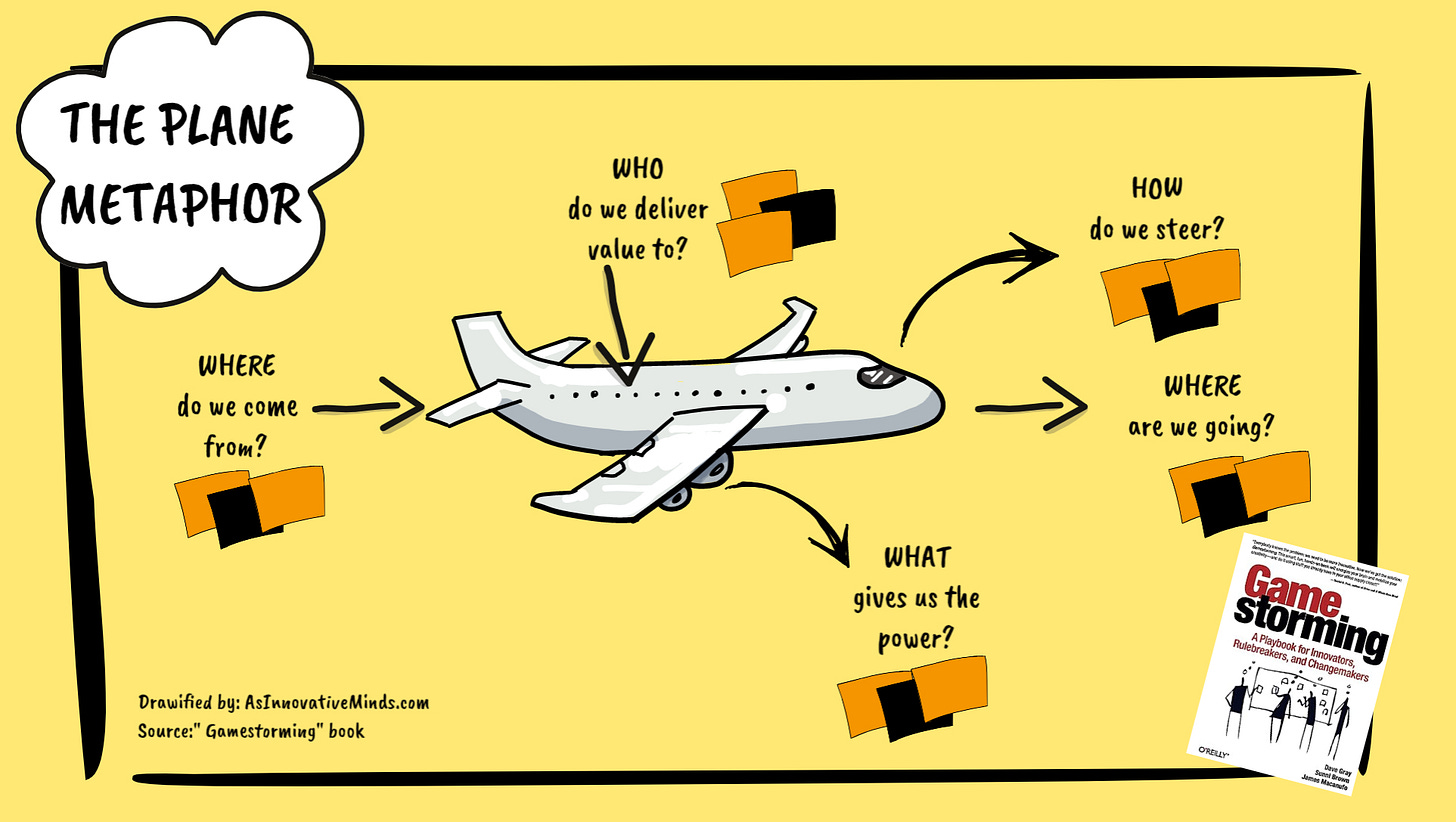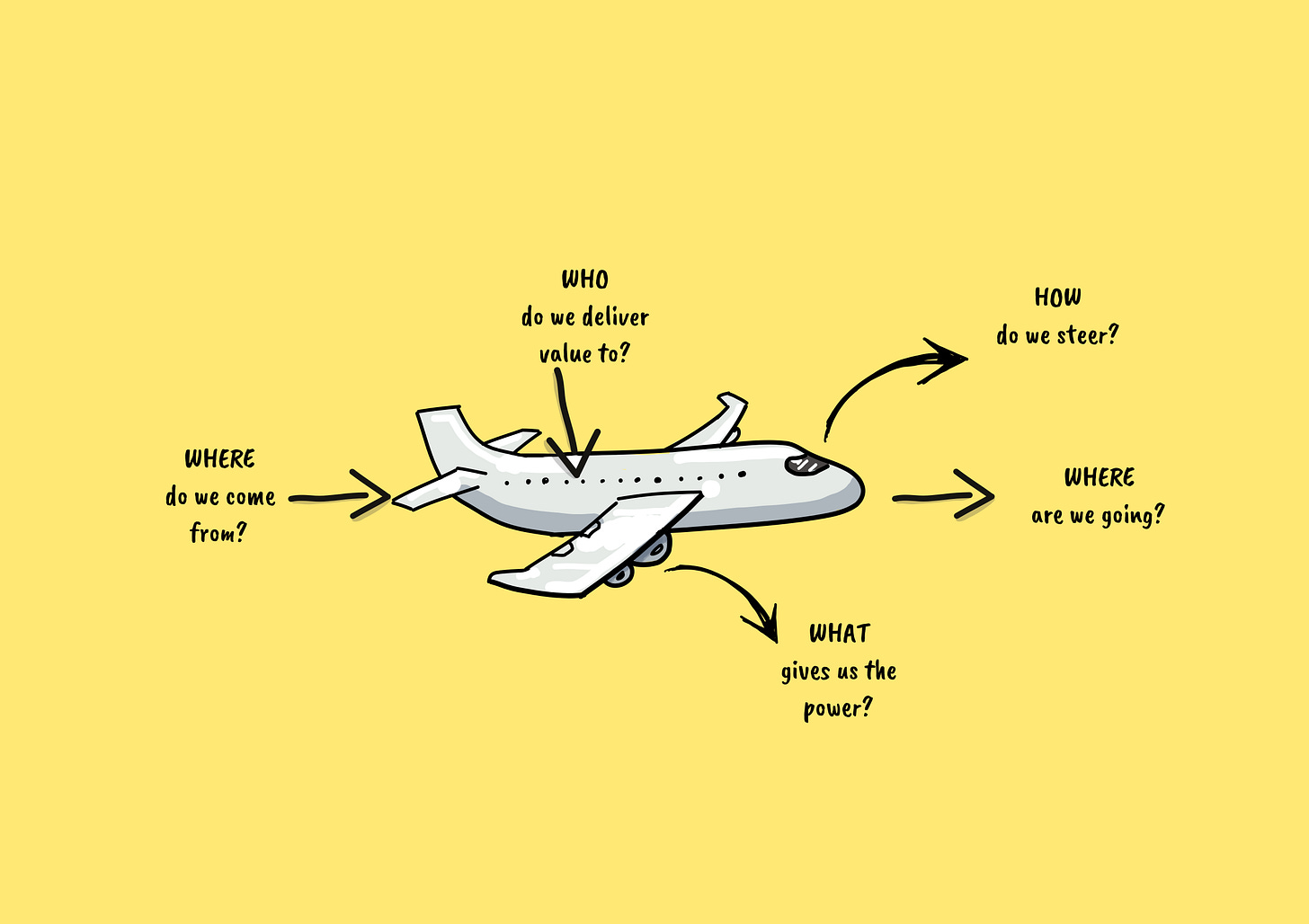How to Get Your Project Off the Ground with a Plane Metaphor Game
Up, Up, and Aligned - article inspired from "Gamestorming" book
This post is about a metaphor I found in the “Gamestorming” book and for which I have the pleasure to invite one of the book’s authors Dave Gray to co-create with me a game for it!
The structure of this post will be following the book game structure, for consistency reasons.
🎲 Summary of the Plane Metaphor and why to use it (neuroscience reasoning)
One way of organizing information is to formulate analogies and conceptual links with other things. The information can be represented by anything that helps you break out of habitual thinking patterns.
We all create our reality when getting external information to our brains. We use our values, opinions, previous experiences, etc. to create our reality and react to the outside world based on this.
A good metaphor comes with a set of associations that will change your perspective and help you think differently about a topic.
This is why it helps your brain to create new associations and get new perspectives, “own realities”.
This is also what the Plane Metaphor will do for you and your team.
🎲 Object of play
The object of this game is to get a project started while aligning team perspectives on different areas.
🎲 Number of players
The session is meant to be used by 3 to 8 players.
🎲 Duration of play
From 90 minutes to 2,5 hours.
🎲 Material required
If the session runs online, you will find useful the Miro template in Miroverse here.
For in-person sessions, you will need:
a printed A1 of the template below
rectangular yellow sticky notes - 1 block per person
sharpies - 1 per person
small round red dots for voting
whiteboard/wall to stick the stickies
whiteboard markers
🎲 How to play
Choose a facilitator who takes care of the sequence and timing. And if you do not have one, it is also fine. Why? Because the game has steps which are enough.
For the in-person session: in a white space visible to the players (whiteboard/flipchart) draw a plane or print the template and stick it to the wall. The sticky notes which will be written will be placed on the picture in the respective areas.
WHERE do we come from? What is the reason why we are here today, which challenges do we have right now? Collect them on sticky notes in silence. Take 5 minutes for this.
Take silent time to read the sticky notes. Use the Miro voting feature to prioritize your challenges and check which ones are the most important for you as a team right now / Use red dots for voting for an in-person session. Take 5 minutes for this.
WHO do we deliver value to? Which are the real users that will use what we deliver? Take 5 minutes to write down the main stakeholders.
WHERE are we going? What is our project goal? Write one sentence that describes where are you going as one team and take into consideration the previous step by thinking for whom do we deliver value. Use the sticky notes and do this exercise in silence. Take 5 minutes for this.
Then share what you wrote one after another. Take questions if they arrive. Take 1 minute per person for this.
HOW do we steer? What are the roles that we take in this project and what we do need from each other? Take 5 minutes to write in silence sticky notes and then share your perspective in 2 minutes per person.
WHAT gives us the power? What would help us reach this goal together better? Which are the motivators for us? Take 5 minutes to write on stickies in silence. Then share what you wrote in 1 minute per person.
Decide upon the next steps after going through this metaphor. The next steps to help you reach the goal, taking into consideration the challenges you have, for whom you do the work, how are you organized to do it and what gives you power. Take 2 minutes per person to share what you think and the facilitator will write down the proposed steps for each person and then create a common way forward together.
🎲 Strategy
The Plane Metaphor can be versatile, but one of the main ideas of its usage is the kick-off of a project. Because it helps to bring all team member’s perspectives together which creates a sense of belongingness and team spirit while “flying” together towards the same goal.
The game has its origin in the book “Gamestorming” together with other mentioned metaphors.
🎲 Complementary games
Impromptu Speed Networking - if the people do not know each other or you have many new members, this game played upfront will help the persons get to know each other in a fun way
Altitude - you can use this game upfront to set expectations and decide depending on the team and project dimensions and context on which level the focus will be
Flip It - it is useful either upfront or after the session to deep dive into the question “Where do we come from?” by looking at the team's fears and flipping them around. We create our reality and this game brings awareness to this fact.
Product Pinocchio - for a team who is working on a new product, after this session, a good game idea is to think of their product as an “alive friend” and personalize it
Empathy Map - Understanding your users deeply using the canvas created by Strategyzer - a game that can follow this session
Pain-Gain Map - when you want after this session to go deeper into understanding the user's pains and gains, then this game is super useful to do
Creating team values - for the team to be able to form and work well together, creating team values and think how to live them would be a proactive approach to avoiding conflicts and broken collaboration
Resources:
Book “Gamestorming” by Dave Gray, Sunni Brown, James Macanufo
Gamestorming website
Want to turn complex information into an eye-catching visual story?
Try Drawify, I got in love ❤️ with it and you can use a special discount (in the link) to play and create visuals as well (I am a Drawify Ambassador).






I agree Luigi, role play is very powerful. I used role play to train my sales team back in the day.
Nice, I have used techniques like this before, but never thought of it as gaming. I guess I have traditionally thought of gaming as something that people 'win' at, but of course it can be as much about the journey as the destination to continue with your metaphor, which landed pretty well :)